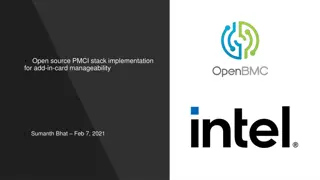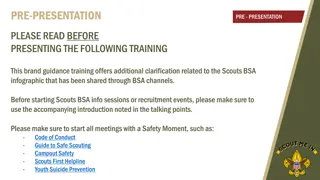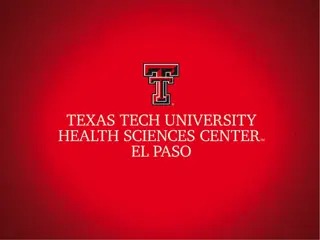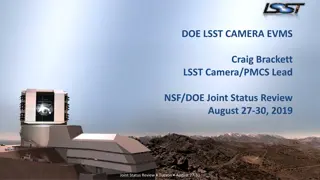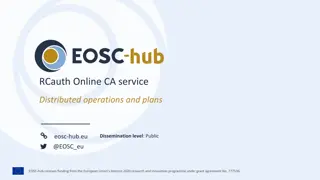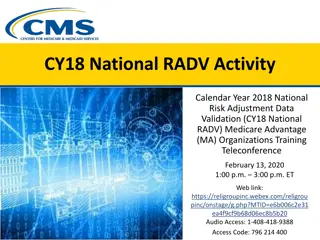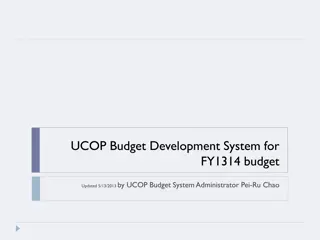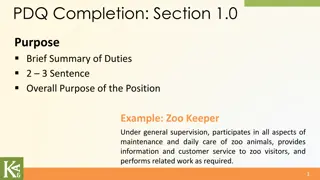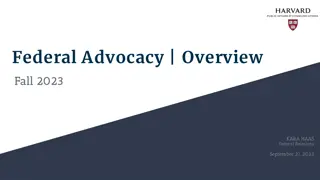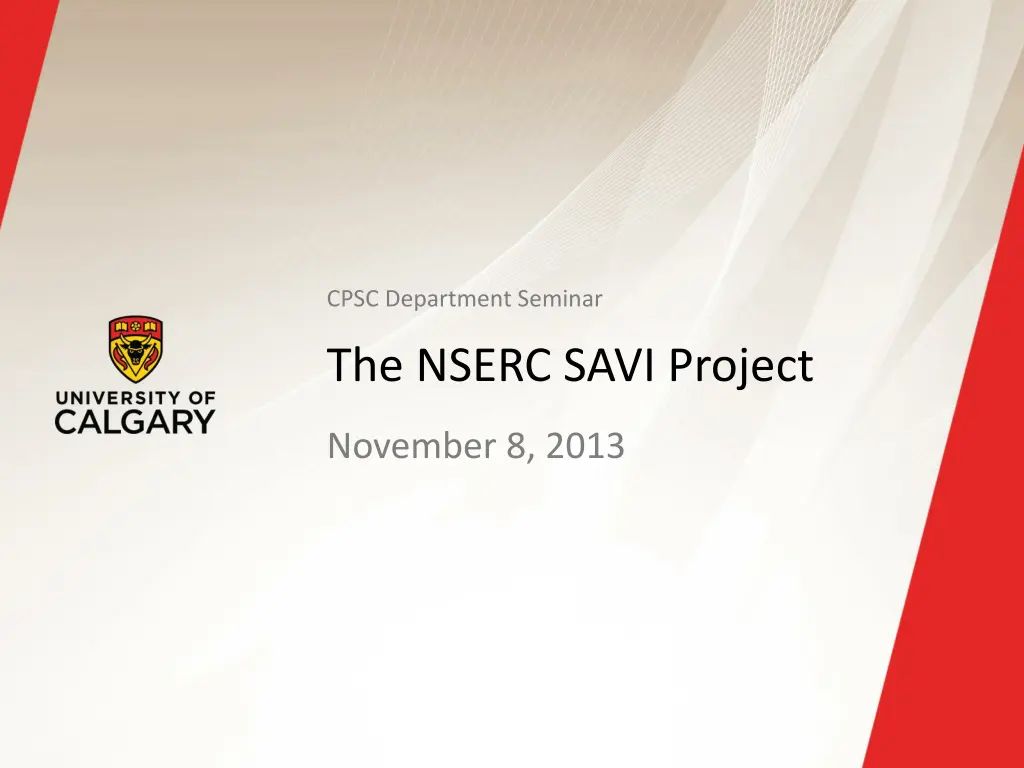
Unlocking the Potential of Virtualization in Networking
Explore the NSERC SAVI Project, focusing on virtual infrastructure and smart applications. Learn about virtualization, SAVI's goals, structure, and team involved in pushing the limits of networking. Discover the innovative approach towards flexible resource management and the future of Software-Defined Everything.
Download Presentation

Please find below an Image/Link to download the presentation.
The content on the website is provided AS IS for your information and personal use only. It may not be sold, licensed, or shared on other websites without obtaining consent from the author. If you encounter any issues during the download, it is possible that the publisher has removed the file from their server.
You are allowed to download the files provided on this website for personal or commercial use, subject to the condition that they are used lawfully. All files are the property of their respective owners.
The content on the website is provided AS IS for your information and personal use only. It may not be sold, licensed, or shared on other websites without obtaining consent from the author.
E N D
Presentation Transcript
CPSC Department Seminar The NSERC SAVI Project November 8, 2013
Outline NSERC SAVI Overview Background: Virtualization SAVI Goals SAVI Structure SAVI Team SAVI Partners SAVI Projects SAVI Testbed SAVI Training SAVI Management 2
SAVI Overview SAVI: Smart Applications on Virtual Infrastructure NSERC Strategic Network Grant $1M per year from NSERC for 5 years (July 2011-June 2016) Additional cash and in-kind from industry partners National collaborative research project (next-gen Internet) PI: Alberto Leon-Garcia (ECE, U of Toronto) Co-investigators: about 12 from across the country U of C participants: Majid Ghaderi (and selected grad students) Carey Williamson (and selected grad students) Sharing $40K/yr for SAVI-related research (Wireless/Edge) 3
Virtualization is the Key The term virtualization refers to a conceptual separation between the logical view of a resource and the physical implementation of that resource (e.g., abstraction or indirection as used in CS) Simplifies management/sharing of resources Enables flexible/efficient/scalable use of resources OS Examples: CPU, memory, disk, file systems NW Examples: VC, VLAN, VPN, subnets, DNS, SDR Cloud Examples: VMs, servers, virtual data centers 4
SAVI Goals The main goal in SAVI is to push the limits of virtualization in networking and closely related areas Any resource can be virtualized and shared Examples: virtual routers, virtual APs, Innovative applications can be built from these (virtualized) resources, once they are made available Flexible, on-demand resource management Current: Software-Defined Networking (SDN) Near Future: Software-Defined Infrastructure (SDI) Far Future: Software-Defined Everything (SDE) 5
SAVI Structure Wireless/Optical Access Massive-Scale Datacenters Smart Edge Virtualized Router & Datacenter Backbone/Core Theme 1: Smart Applications Theme 2: Extended Cloud Computing Theme 3: Smart Converged Edge Theme 4: Integrated Wireless/Optical Access Theme 5: SAVI Application Platform Testbed 6
SAVI Team U. Victoria: Hausi M ller U. Alberta: Eleni Stroulia U. Calgary: Majid Ghaderi, Carey Williamson U. Toronto: Paul Chow, Yashar Ganjali, Baochun Li, Alberto Leon-Garcia (PI) York U.: Marin Litoiu U. Waterloo: Raouf Boutaba, Ken Salem Carleton U.: Murray Woodside McGill U.: Tho LeNgoc Laval U.: Leslie Rusch Industry Liaison: David Mann 7
SAVI Partners Partners Smart Applications Extended Cloud Smart Converged Edge Integrated Wireless/ Optical SAVI Test Bed Telus x x x x x MTS Allstream x x x IBM x x x x INSA Corp x x x Seawell x x Cisco x x x x Ciena x x Juniper x x x Ericsson x x x x x DragonWave x x BelAir x x x Wesley Clover x x ORION x 8 SciNet x x x
Theme 1: Smart Applications Project 1.1. Future-Oriented Application Classes Large-scale data-intensive applications User-centric applications on smart mobile devices Real-time collaborative virtual reality applications Project 1.2. Reusable Application Frameworks for Rapid Deployment Massively-parallel computation and distributed peta-scale storage Mobile online presence and collaboration System-wide event generation and notification Project 1.3. Adaptive Deployment of Future-oriented Applications in the SAVI platform Run-time binding between applications and reusable services Run-time adaptation of application deployment to varying resource availability Interacts with Extended Cloud Computing & Smart Edge 9
Theme 2: Extended Cloud Computing Project 2.1: Adaptive Management Framework for Extended Cloud Environment Framework for design and analysis of adaptive cloud management Goal management in hierarchical adaptive systems Runtime supply chain management Project 2.2 Optimization for Resource Adaptation Partitioning computing and storage between edge and core Strategies and layer coordination in cloud computing Forecasting Project 2.3 Storage and data services in the Extended Cloud Two-Tier Storage Services Support for Bi-Directional Data Streams Management of Limited Edge Resources Interacts with Smart Applications & Smart Edge 10
Theme 3: Smart Converged Edge Project 3.1: Virtualized Smart-Edge Architecture Virtualization at demarcation between Access and the Smart Edge Infrastructure for Packet Transport in the Smart Edge Supporting Services and Applications in the Smart Edge Project 3.2: QoE and Resource Measurement and Provisioning Key Performance Indicators for User Experience Online QoE Measurement Dimensioning Resources for Virtual Networks Project 3.3: Virtual Resource Management in the Smart Edge Algorithms for resource management in the smart edge Adaptive scaling and migration of virtual networks in the smart edge Reliability and fault tolerance in virtual networks Interdomain virtual network management Interacts with Smart Applications, Extended Cloud Computing, and Integrated Wireless/Optical Access 11
Theme 4: Integrated Wireless Optical Access Project 4.1: Design of Virtualized Wireless/Optical Access Testbed Virtualizing the digital optical/wireless interface Radio over Fiber Spectrally efficient virtualization Project 4.2: Very-High Bandwidth Dense Small-Cell (DSC) Access Testbed Virtualized broadband wireless access Dense Small-Cell Access Networks Project 4.3: Energy Proportional Adaptive Capacity Resource Management Inter-VRM: Inter Virtual Network Resource Manager Intra-VRM: Intra Virtual Network Resource Manager 12
Theme 5: SAVI Application Platform Testbed Project 5.1: SAVI Converged Virtual Cluster and Virtual Networks SAVI Cluster prototype for the smart edge Design of secure SAVI cluster Virtualization of fabric bandwidth Project 5.2: Design of SAVI control and management planes Design of SAVI management plane using SOA & Web Services Design of SAVI control plane using OpenFlow Project 5.3: Testbed Activities and Integration of Research Themes Integration of Smart Applications with Extended cloud computing and smart edge Integration of Integrated Wireless/Optical access and smart edge 13
SAVI Testbed An experimental national testbed for SAVI researchers SAVI core node at U of T (data center clearinghouse) SAVI edge nodes: U. Victoria U. Calgary (since October 2013) U. Toronto (has two edge nodes as well) York U. U. Waterloo Carleton U. McGill U. SAVI testbed is also federated with GENI testbed in USA U of C equipment includes an OpenFlow switch and a controller for the switch (running the SAVI software for system config (whale) and cloud services (janus, nova)) Physically located in ICT 619 (IP 136.159.3.194) 14
SAVI Testbed Plan Experiments in the Lab Year 1 1. Create isolated apps that use video and mobility & require Experiments in the Lab Year 1 autonomic behaviour in the cloud & edge Experiments on Small Network Year 2 Multinode Network Experiments Year 3 Full Testbed Capability Year 4 & 5 Demonstrate smart apps over virtual cloud infrastructure Extend to proof-of- concept at scale testbed; Provide network slices; Demonstrate smart apps over virtual extended cloud infrastructure (integrated cloud & smart edge Buildout applications and virtual infrastructure to multiple locations 2. Develop resource management for cloud based infrastructure Demonstrate smart apps over virtual smart edge infrastructure (SAVI cluster) 3. Examine edge opportunities for SAVI cluster, programmability, ASA Demonstrate slices of wireless/optical access network Campus-wide test with wireless cells & optical backhaul Demonstrate integrated WiFi/ LTE over Fiber 4. Theorize potential solutions from wireless/optical access between the apps and the smart edge Interconnect two SAVI clusters 5. Build up the testbed theme -Isolate control plane -Identify authorization capabilities -Define SAVI-ized cluster requirements 15
SAVI HQP Training SAVI HQP development targets preparation of researchers and engineers that meet the future needs of industry and government 65% of NSERC Funds to support 5 postdocs, 24 graduate students, and 10 undergrads per year Multidisciplinary training program Virtual research teams span multiple universities & disciplines SAVI-wide seminar speaker series Builds on successful programs on network engineering Interaction with multiple disciplines and industries Interaction with many researchers, developers, executives Graduates versed in both technology & business context (i.e., both tech-savvy and business-savvy) 16
SAVI Internship Program Four-month internships to stimulate interaction between SAVI graduate students & industry partners Available to NSERC and partner-supported students Builds on MET Architect-in-Residence program at U of T MITACS Matching Program Partner: $6K, MITACS: $7.3K Partner-defined Masters projects Expands scope of SAVI research program & bridges gap between near-term and 5-10 year horizon Additional 24 Masters students/year Maximize potential for technology & knowledge transfer Seamless transition from academia to industry 17
SAVI Partner Contributions IBM Software Licenses Juniper Router SDK & Support Ericsson LTE Evaluation Facility ORION GE Connectivity Belair Picocells 18
SAVI Management (1 of 2) Board of Directors Guiding SAVI to achieve its objectives Overall management, direction, policies, financial accountability Host Institution, Scientific Director, Researcher, at least 2 Industry Partners, R&E/HPC partner, international researcher from testbed initiative Network Manager & NSERC Rep (non-voting) SAVI has the support of industry at executive levels to build a strong & effective BoD Board of Directors Research Program Committee Scientific Director Network Manager Scientific Director A. Leon-Garcia Internationally-recognized researcher Leading multi-university projects Leading startup with >100 engineers Leading industry-oriented graduate programs Linked-in with Canadian industry 19
SAVI Management (2 of 2) Research Program Committee Theme leads & partners Annual review of research progress Recommends research projects to BOD Identifies projects with high commercialization potential Network Manager Vladi Cirillo Responsibility for coordination & mgmt of SAVI activities HQP, internship, knowledge/tech transfer, partnerships Report preparation, AGM, financial control Admin Assistant Financial accounting, communications, internship placement paperwork Communications Partner webpage & newsletter Regular seminar/lecture series External communications programs to stimulate SAVI awareness Testbed lead: Hadi Bannazadeh Tech support; site coordination; equipment specs; software mgmt; accounts; documentation; issues Training workshops at SAVI AGM 20
SAVI Summary SAVI is an NSERC Strategic Network Smart Applications on Virtual Infrastructure National-scale collaborative research to advance the state of next-generation networking in Canada Will establish a flexible infrastructure to foster a marketplace of innovative new network applications Questions? 21

![❤[READ]❤ Deep Space Craft: An Overview of Interplanetary Flight (Springer Praxis](/thumb/21511/read-deep-space-craft-an-overview-of-interplanetary-flight-springer-praxis.jpg)




